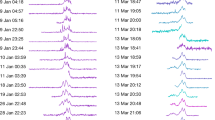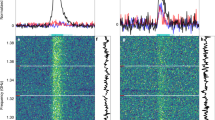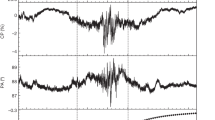Abstract
WE detected a second outburst with a high degree of linear polarisation from Cyg X-3 in August 1975, following the alert by Kawajiri1. The first such outburst was observed in May 1974 (refs 2 and 3). Here we report observations of both polarised outbursts as well as of an unpolarised outburst in January 1975. At 8 GHz the observed polarisation position angle was the same for both polarised outbursts. The Faraday rotation measure associated with the source is much larger than previously reported2. We suggest that the orientation of the magnetic field in the source and the rotation measure are both stable with time. In addition, we find that the highly polarised outbursts decay significantly more slowly than the unpolarised outbursts.
This is a preview of subscription content, access via your institution
Access options
Subscribe to this journal
Receive 51 print issues and online access
$199.00 per year
only $3.90 per issue
Buy this article
- Purchase on Springer Link
- Instant access to full article PDF
Prices may be subject to local taxes which are calculated during checkout
Similar content being viewed by others
References
Kawajiri, N., IAU Circ., No. 2819 (1975).
Seaquist, E. R., et al., Nature, 251, 394–396 (1974).
Kawano, N., and Kawajiri, N., Publs astr. Soc. Japan, 27, 191–193 (1975).
Aller, H. D., Astrophys. J., 161, 1–18 (1970).
Aller, H. D., and Dent, W. A., Nature phys. Sci., 239, 121–123 (1972).
Aller, H. D., and Hodge, P. E., Nature phys. Sci., 245, 40–41 (1973).
McEllin, M., Mon. Not. R. astr. Soc. 175, 5P–8P (1976).
Hjellming, R. M., Brown, R. L., and Blankenship, L. C., Astrophys. J. Lett., 194, L13–L18 (1974).
Manchester, R. N., Astrophys. J., 188, 637–644 (1974).
Vallée, J. P., and Kronberg, P. P., Astr. Astrophys., 43, 233–242 (1975).
Chu, K. W., and Bieging, J. H., Astrophys. J. Lett., 179, L21–L23 (1973).
Lauqué, R., Lequeux, J., and Nguyen-Quang Rieu, Nature phys. Sci., 241, 94–95 (1973).
Becklin, E. E., et al., Nature, 245, 302–304 (1973).
Parsignault, D. R., et al., Nature phys. Sci., 239, 123–125 (1972).
Peterson, F. W., Nature, 242, 173–177 (1973).
Marscher, A. P., and Brown, R. L., Astrophys. J., 200, 719–726 (1975).
McEllin, M., Mon. Not. R. astr. Soc., 170, 1P–6P (1975).
Aller, H. D., Nature phys. Sci., 239, 128 (1972).
Dent, W. A., Nature phys. Sci., 239, 127 (1972).
Author information
Authors and Affiliations
Rights and permissions
About this article
Cite this article
LEDDEN, J., HODGE, P. & ALLER, H. The second highly polarised radio outburst in Cygnus X-3. Nature 262, 669–671 (1976). https://doi.org/10.1038/262669a0
Received:
Accepted:
Issue Date:
DOI: https://doi.org/10.1038/262669a0
Comments
By submitting a comment you agree to abide by our Terms and Community Guidelines. If you find something abusive or that does not comply with our terms or guidelines please flag it as inappropriate.



